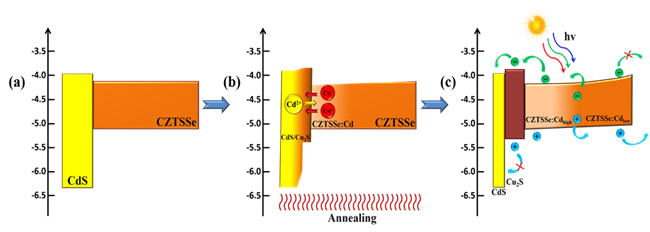Research Team of Nankai University Made a Great Progress in CZTSSe Solar Cell Field
Recently, professor Zhang Yi and his students, from the College of Electronic Information and Optical Engineering, Nankai University, achieved a great progress in the research of CZTSSe thin-film battery. The team designed an ideal band gap gradient and a new heterojunction structure in light of the characteristics of element diffusion caused by heterojunction annealing in CZTSSe solar cells and ion exchange reaction at the interface, in collaboration with Wang Gang, an associate researcher at Changchun Institute of Applied Chemistry, the Chinese Academy of Sciences, Wang Shenghao, a professor at Shanghai University, and Hao Xiaojing, a professor at the University of New South Wales, Australia, etc.
After the CZTSSe/CdS heterojunction annealing, Cu+ in the absorption layer and Cd2+ in the buffer layer will have an ion exchange reaction at the interface. The Cd gradient doped CZTSSe will form on the absorption layer, in the mean time, the CdS part will transform into Cu2S. The formation of a graded Cu2S/CZTSSe: Cdhigh/CZTSSe: Cdlow band gap arrangement can be determined according to the conduction band arrangement in the absorption layer.

Fig. (a) energy band diagram of CdS/CZTSSe;
(b) diffusion diagram of Cu+ and Cd2+ions in heterojunction annealing;
(c) energy band diagram of CdS/Cu2S/CZTSSe:Cdhigh/CZTSSe:Cdlow
The formation of band gap gradient in the absorption layer has effectively reduced the carrier recombination. In the meantime, CuZn defects in the device are transformed to shallower VCu defects, which will further help to improve the free carrier concentration and the device conductivity. Thanks to the advantage of the band gap gradient in the absorption layer, the open circuit voltage and filling factor of the battery have been significantly improved and the efficiency of CZTSSe solar cell is increased by 45% than the traditional workmanship. As the research team overcame the predicament of band-gap-graded CZTSSe solar cell by applying simple and effective methods in this work, members of the team said it "illuminates a bright light on the future road to high efficiency solar cell."
Relevant results of the project was published in Energy & Environmental Science (DOI: 10.1039/D1EE03134A.) under the title "Band-gap-graded Cu2ZnSn(S,Se)4 drives high efficient solar cells". Doctoral student Guo Hongling is the first author of the paper, Professor Zhang Yi, associate researcher Wang Gang, and Professor Hao Xiaojing are the co-corresponding authors, and Nankai University is the first author unit. This work has been supported by the key projects of National Key R&D Program of China and the National Natural Science Foundation of China.
Article link: https://doi.org/10.1039/D1EE03134A
(Edited and translated by Nankai News Team)









